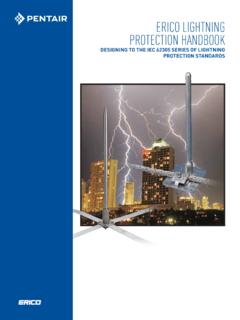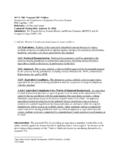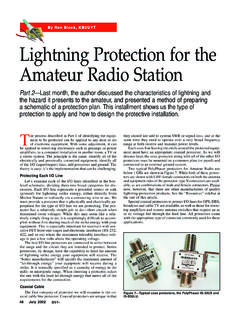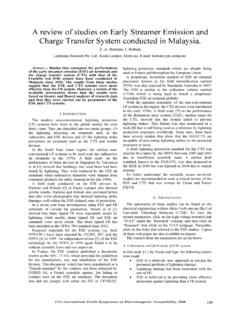Transcription of Over-Voltage Protection of Insulated Joints in …
1 ALWAYS RUGGED. ALWAYS Protection of Insulated Joints in Joints in pipelines may be subject to Over-Voltage failure due to lightning and, in some applications, AC voltage. When a pipeline is near an electric transmission line, it can be subject to significant AC voltage if a phase-to-ground fault occurs. Over-Voltage Protection against both lightning and AC fault conditions is possible using appropriately rated products, and is required for Protection of equipment and personnel. Various types of Insulated Joints appear in pipeline facilities, including fittings in measurement tubing, threaded unions, flanged insulators, and monolithic insulators. All types can fail if not addressed, and should have Over-Voltage Protection .
2 Solid-State Over-Voltage ProtectionA solid-state Protection device connected across the Insulated joint will limit the voltage to safe levels, and provide a conduction path around the joint, protecting the insulation system. Devices switch into this protective mode during an event, and then automatically switch back into the OFF state to isolate the cathodic Protection system. Dairyland offers a large selection of products specifically designed to provide Over-Voltage Protection for Insulated Joints in cathodically protected systems. Solid-state products offer numerous benefits over alternatives including: Fail-safe construction for assured safety grounding, maintenance-free operation, high ratings for AC fault current and lightning , safe turn-on voltage level, and Dairyland is known for outstanding technical support.
3 In addition, products commonly used for this application have extensive third party certifications, discussed below. Safety Regulations Affecting Insulated Pipeline Pipeline Safety Regulations: When the voltage across an Insulated joint exceeds the voltage withstand level, arcing will occur either through or around the joint insulation and current will flow. Arcing can damage and short out the joint, or in the event of a leak at the joint, a combustible atmosphere may be present and may be ignited by the arc (assuming the pipeline is carrying a flammable material). To protect personnel and public against this possibility, Section (e) and (f ) of the Pipeline Safety Regulations requires protective measures to prevent arcing across Insulated Joints , both for lightning and AC fault current.
4 These protective measures require the installation of a suitable Over-Voltage protective device across the Insulated joint. This regulation also incorporates by reference the US National Electrical Code, further requiring compliance to electrical product safety standards. Dairyland products meet these requirements (likewise in Canada per the Canadian Electrical Code and hazardous location standards). Similar International Regulations: Due to the universal risk of unmitigated Over-Voltage affecting safety at Insulated Joints , many world-wide governing and technical authorities mandate actions to prevent these hazards. Either under the health and safety regulations, or regarding product use in hazardous locations, authorities require Protection product use at Insulated Joints .
5 Dairyland products are third-party certified to numerous international standards to assure users and regulators that the highest level of care has been applied to product design and use. Examples of such certifications include UL, ATEX, IECEx, EAC, among other standards and certification systems. Why Not Use an Arrester?Some companies consider using spark gap arresters to address Over-Voltage concerns on Insulated Joints . However, these products have some serious shortcomings compared to solid-state Over-Voltage Protection devices and are not recommended. Fail-Safe ConstructionDairyland devices are considered fail-safe. If exposed to fault current values beyond their already high ratings, Dairyland devices will always fail safely and un-eventfully in the shorted mode (fail as a dead-short), bonding the two points together for safety.
6 This assures that Over-Voltage conditions will be addressed whether the product is working or failed. (Failures are exceedingly rare due to the high energy capability of the products.) A gapped arrester has an open gap, which will always remain an open gap. If the arrester were to fail, it would be as an open circuit. After failure, an arrester provides no Over-Voltage Protection and a potential safety hazard is created, as voltage can rise to unsafe Fault Current By design, Dairyland devices have the ability and ratings to handle AC fault current, with published and tested rating data to assure long-lasting performance. Devices such as gapped arresters do not have published AC fault ratings (or have minimal ratings) as they are not intended for such faults, yet AC conditions on pipelines are common.
7 Over-Voltage Protection of Insulated Joints in PipelinesLow Threshold VoltageDairyland devices have a low threshold voltage, typically 2 or 3V, and begin voltage clamping just above the blocking threshold voltage of the device. This assures that over-voltages will be clamped to the lowest levels, providing a significant advantage for personnel safety and for applications such as Insulated joint Protection . Arresters typically conduct at hundreds to low thousands of CapabilitiesDairyland devices will handle 75,000A or 100,000A (depending on model selected) of lightning surge current. The device goes into conduction at a much lower voltage than a gapped arrester, keeping the voltage across the Insulated flange to a low value.
8 For lightning surge conditions, after initial conduction at the several volt threshold, the voltage across the device is approximately 100V. The voltage allowed across a gapped arrester, in comparison, will reach unsafe levels prior to conduction, exposing personnel and equipment to this voltage until the device Product SelectionGuidelines for selecting a protective product for Insulated Joints are as follows:Site conditionsInduced ACWhere no induced AC voltage is present, such as Insulated Joints on airport fueling systems or within a facility, the products of choice are the OVP (Div 1 or Zone 1 hazardous locations) or OVP2 (Div 2 or Zone 2 hazardous locations).
9 Avoid use of OVP/OVP2 where induced AC is present, or expected, otherwise full conduction will affect cathodic Protection levels. Often, users assume that a low value of induced AC voltage is present and apply the OVP or OVP2, when they should instead default to a decoupler, such as the SSD, PCR, or PCRH, which can mitigate AC while blocking DC. With induced AC voltage present across the joint, the products of choice are the PCR or SSD, assuming the joint is classified as an ordinary, Div 2, or Zone 2 hazardous location. If the joint is in a confined space it is likely a Div 1 or Zone 1 hazardous location, thereby requiring a PCRH. When in doubt about the level of induced AC voltage present, or for any cross-country pipelines that may have nearby paralleled power lines in the future, the best approach is to apply a decoupler (SSD, PCR, PCRH) instead of an OVP or OVP2.
10 Electrical ratingsAC Fault CurrentSelect a product AC-rms current rating that is above the expected site value. Where induced AC voltage on a pipeline has been modeled, use the modeled value for Insulated joint Protection as well. For cases where the fault current is not known, apply a AC-rms rated product by default, unless other site conditions indicate that this value should be altered. Don t forget to select a conductor or attachment method that is also rated for this AC fault current. The Dairyland website contains guidance on relating conductor size to VoltageThis voltage, measured between the product terminals, determines when the product changes from blocking DC to full conduction (switches ON) to provide Over-Voltage Protection .









